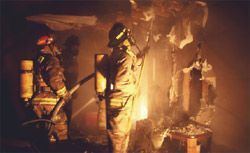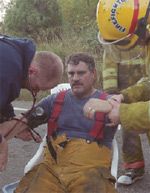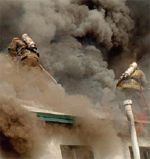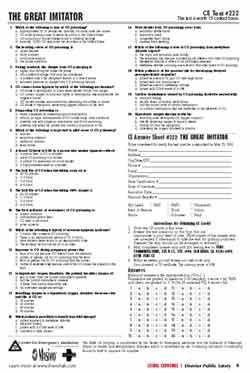By DANA BARTLETT
| OBJECTIVES
|
Ever since humans discovered that burning wood would keep them warm, people have been exposed to carbon monoxide (CO). Despite widespread public awareness and education, CO poisoning is still all too common; it is the No. 1 cause of death by poison in the United States. In its annual report for 2004, the American Association of Poison Control Centers (AAPCC) recorded more than 75,000 exposures to carbon monoxide and 74 deaths, and it is likely that there are many cases of CO poisoning that are never brought to a physician’s attention or are misdiagnosed. CO poisoning causes significant morbidity and death, and consumes first responder and emergency department resources. In short, CO poisoning is a serious national health problem.
CO sources
Carbon monoxide is aptly called the silent killer. Odorless and colorless, CO is produced by incomplete combustion of a carbon-containing fuel, and exposure can be fatal. Oil and other petroleum products, natural gas, coal and wood can all be sources. Devices such as furnaces, ovens, space heaters and water heaters are all potential CO generating culprits. Automobile exhaust is the biggest source of CO, followed by fire smoke inhalation.1
 PHOTO STEVEN FRANK The risk of CO exposure during a fire is prolonged and potentially deadly, and it does not end once the fire is under control. |
Note: A lesser known source of carbon monoxide is the vapors from methylene chloride, a compound commonly found in paint strippers. When the fumes are inhaled, it is converted in vivo to carbon monoxide.
CO produced by fuel-burning devices in the home is not usually a problem in well-maintained devices that are properly ventilated. Problems occur when these devices are not properly maintained or serviced, or when ventilation systems become blocked, such as a dryer filter packed with lint or a furnace flue blocked by a bird’s nest. Dangerous levels of CO can accumulate quickly with catastrophic results. Many cases of CO poisoning in the home are preventable with maintenance, inspection and proper ventilation.
There are also less-obvious sources of CO exposure. People have been poisoned by CO when riding in the back of a pickup truck, riding in a powerboat, operating forklifts in a factory, using hibachi grills and after being exposed to the fumes from a gas log fireplace.
Lesser known risky activities include glassblowing, working with ceramics, commercial jewelry making and welding. Some outdoor sports involve equipment that can produce toxic levels of CO, such as stoves used in mountaineering tents or faulty SCUBA gear used in diving.
On-scene considerations
Many calls involving carbon monoxide — faulty furnaces, exposure to automobile exhaust, etc. — do not pose a significant risk to EMS or fire personnel, or the risk is easily managed. Dealing with fires is a different matter. The risk of CO exposure during a fire is prolonged and potentially deadly, and it does not end once the fire is under control. When responding to a fire, fire and EMS crews can quickly find their role of responder change to the role of victim. To prevent that, crews must implement on-scene rehabilitation (i.e., rehab) and remain vigilant regarding potential CO poisoning during overhaul.
Rehab is achieved by periodic, supervised rest periods for firefighters; it is care given to firefighters and other emergency personnel on scene. Fighting fires places personnel at risk for CO poisoning, but there is also the danger of heatstroke, dehydration and cardiac problems. Incident commanders assess the risk and ensure that responders have access to rest, fluids, food, medical attention and CO monitoring. Note: The U.S. Fire Association (USFA) has specific guidelines that specify how rehabilitation services should be set up and provided.2
Overhaul is more complicated. It refers to seeking out and extinguishing any remaining fires, eliminating rekindles, stabilizing the incident scene and securing the structure. This phase of fire control can be very time consuming, and personnel may be involved for hours. Overhaul may also appear to be relatively risk-free, and that is one of its dangers. CO levels in smoldering fires and during overhaul operations can be very high, certainly high enough to cause impairment.
A study performed in Phoenix showed that in 20% of the fires examined, the CO level during overhaul exceeded the National Institute of Occupational Safety and Health’s short-term exposure limit of 200 parts per million (ppm).3 However, during overhaul, there may be a tendency to overlook this fact. Fire crews may perceive that because the fire is out, there is no longer a danger, and that it’s safe to remove SCBA. This can prove dangerous, exposing personnel not only to CO, but many other byproducts of combustion.
Pathophysiology
The pathophysiology of CO poisoning is complex. However, despite the many mechanisms by which CO produces poisoning, they each produce the same result: preventing oxygen from reaching tissues. CO produces tissue hypoxia by the following mechanisms:
- Binding to hemoglobin. Hemoglobin is a protein-iron complex that binds with oxygen and delivers it to the tissues. CO also binds with hemoglobin (the CO hemoglobin complex is called carboxyhemoglobin), but it does so much more avidly; the affinity of CO for hemoglobin is 200-250 times greater than that of oxygen. If CO is present in the blood, there may be adequate oxygen in the inspired air, but it must compete, unsuccessfully, with CO for hemoglobin-binding sites.
- Transfer of oxygen to the tissues. Even in cases of CO poisoning, there is some binding of oxygen to hemoglobin. However, in the presence of carboxyhemoglobin, oxygen is much more tightly bound to hemoglobin, and it is not released to tissues. Tissue oxygen pressures must be dangerously low before the oxygen is released.
 PHOTO GERT ZOUTENDIJK Incident commanders must assess the CO risk to firefighters and ensure that responders have access to rest, fluids, food, medical attention and CO monitoring during operations. |
These mechanisms are the “classic” explanations of why CO poisoning affects oxygen delivery. But research suggests that although CO binding to hemoglobin and decreased release of oxygen may be important components of CO poisoning, they do not completely explain the clinical picture. In addition, the damage done by CO is probably not completely explained by those two effects. Other mechanisms are probably more important, and they can be divided into these categories:
- Depressed cardiac function;
- Action as a vasodilator. CO increases the activity of guanylate cyclase (an enzyme that catalyzes the formation of cyclic guanosine monophosphate, a potent vasodilator) and causes the release of nitric oxide (a potent vasodilator) from platelets. Vasodilatation decreases the oxygen delivery to tissues by causing pooling of blood in the vascular bed;
- Decreased oxygen utilization. CO also binds to myoglobin, a protein-iron complex that transports oxygen within the cells; and
- Free-radical formation. The release of nitric oxide from platelets initiates the formation of free radicals. Also, the tissue damage caused by poor perfusion and lack of oxygen attracts leukocytes to the damaged area. This initiates and sustains an inflammatory response and also causes freeradical formation. (This process is essentially a tissue reperfusion injury, similar to what is seen in patients who have suffered a myocardial infarction.)
In summary, CO: 1) prevents oxygen from being delivered (by the formation of COHb and increased binding of oxygen to hemoglobin); 2) causes tissue hypoxia (by the above mechanisms along withdepression of cardiac function and vasodilation); and 3) stimulates the production of free radicals that damage tissue.
 PHOTO MIKE MEADOWS When responding to a fire, crews must take the necessary PPE precautions to prevent CO exposure. |
Clinical signs & symptoms
CO has been called the great imitator. The signs and symptoms of CO poisoning are changeable, non-specific and often mild. The patient may have a slight headache and complain of a lack of energy. Even if symptoms are severe, CO poisoning can be easily misdiagnosed. CO poisoning may be mistaken for food poisoning, influenza, a cerebral bleed or a migraine headache. If there is no obvious situation involving CO (e.g., a fire), it can be difficult to spot these cases. But remember two points: 1) Examine the patient and take a history, taking into account the situation surrounding the patient and their illness and; 2) CO poisoning causes tissue hypoxia, and the signs and symptoms of CO poisoning will reflect this. If you suspect CO poisoning, but there is no obvious source, ask the patient the following questions:
- Do you feel sick now? If not, where, specifically, are you when you feel sick? If the patient reports that they feel sick at home, and their symptoms improve when they are out, that is a sign that CO may be involved.
- Whom do you live with? Has anyone else been sick? If the patient is living with other people, but no one else is sick, CO exposure is unlikely.
- What type of heating system do you have, and was it operating when you were symptomatic? Patients often suspect they have CO poisoning, but the symptoms occur when the heating system is not on, e.g., during the summer.
- Have you recently checked/maintained your heating system, water heater, etc., and the devices’ exhaust systems?
- Do the symptoms occur when you are driving your car? When was the last time the car’s exhaust system was inspected?
- Do the symptoms happen at work? Do you work indoors in a situation in which CO is produced (e.g., inside a garage or warehouse with forklifts operating, etc.)?
- Have you recently stripped paint or varnish off any furniture?
- How long have you suffered the signs and symptoms? What are the signs and symptoms? A viral illness typically lasts five to seven days. Patients who have CO poisoning from a source that is not obvious may have signs and symptoms for weeks or months. Also, some symptoms of certain viral infections, such as sore throat or fever, are very unlikely to be due to CO poisoning.
- If there are multiple patients, did everyone become sick at the same time? A viral/infectious illness usually starts with one person and then spreads to the others. In CO poisoning involving many people, everyone will become sick at approximately the same time. (This is also true of food poisoning that affects large groups of people, but the situations in which CO and food poisoning occur usually differ.)
| PATIENTS AT HIGH RISK FOR NEGATIVE OUTCOME |
decreased oxygen-carrying capacity; and
After the interview, move on to the physical exam. Again, CO poisoning does not produce signs and symptoms that are distinct. However, responders may recognize cases by remembering that CO poisoning causes decreased oxygen delivery to, and decreased oxygen utilization by, organs that are very active metabolically. CO poisoning affects the following systems:
- Neurologic: CO poisoning causes central nervous system depression, and the effects of CO poisoning can be arranged on a continuum of impairment. In mild cases, the patient may complain of a headache, dizziness and confusion or may have difficulty with abstract thinking or have ataxia. In severe cases, the patient may be comatose or develop seizures.
- Cardiac: The cardiac signs of CO poisoning reflect the decreased myocardial function and vasodilation CO causes (e.g., the patient may be hypotensive) and reflect the decreased oxygen delivery to, and utilization of, oxygen by the myocardium (e.g., the patient may have tachycardia, chest pain, arrhythmias or myocardial ischemia). Most deaths from CO poisoning result from ventricular dysrhythmias.
- Metabolic: Respiratory alkalosis is possible in mild cases, and metabolic acidosis is common in severe exposures.
- Pulmonary: Pulmonary edema occurs in 10–30% of acute CO exposures. This may be due to a direct effect on the alveolar membrane, left ventricular failure, aspiration or neurogenic pulmonary edema.
- Renal: Rhabdomyolysis and renal failure are possible.
Remembering all the effects caused by CO can be difficult. It’s much easier to simply remember this fact: CO interferes with the delivery to, and utilization of, oxygen by organs with a high need for oxygen. The signs and symptoms of CO poisoning reflect this fact.
Note: CO poisoning by methylene chloride vapors can be prolonged. The enzymes that metabolize methylene chloride become saturated when the level is too high. Methylene chloride is then stored in fat tissue and slowly released.
Laboratory confirmation
The laboratory can provide unequivocal proof that a patient has been exposed to CO. A carboxyhemoglobin level is drawn (both venous and arterial blood can be used; if using venous blood, a lithium heparin tube must be used), and if it is above 1-2%, there is a possibility that the patient was exposed to CO. However, levels must be interpreted with several facts in mind.
CO naturally occurs in the body, and a level of 1-2% is normal. Cigarette smoke contains CO, and smokers can have a “normal” level of 4-5%. Some smokers might have a chronic level of 10%.
Also, the length of time between the exposure and the level is important. The lungs naturally excrete CO; the half-life of CO is four to six hours when the patient is breathing room air, and 40-60 minutes when the patient is breathing 100% oxygen. If transport time is 30 minutes and the patient has been breathing 100% oxygen during that time, it will be difficult to know when the level peaked.
More importantly, there is a poor correlation between a COHb level and the clinical presentation of the patient. This is particularly true of the neurologic effects of CO exposure. This is also true of patients with coronary artery disease; they may develop angina and/or arrhythmias at CO levels that are tolerated by patients with healthy hearts. This is thought to be because the COHb level in the blood does not accurately predict the CO level in the tissues. An elevated COHb level is certainly a cause for concern, but the clinical presentation of the patient is a better indicator of how sick he or she is. Also, the COHb level is a poor predictor of the outcome of any particular exposure.
It is important to note that pulse oximetry does not accurately reflect oxygen saturation if the patient has been exposed to CO. The readings will be falsely high, and the difference between the pulse oximetry reading and the actual saturation of hemoglobin with oxygen increases as the COHb increases.
What levels of COHb are dangerous? Some authors have tried to correlate the COHb level to specific signs and symptoms, but there is ample evidence that suggests this can’t be done; patients with high levels will not necessarily be sicker than patients with lower levels.4 The current Occupational Safety and Health Administration (OSHA) limit for the average amount of CO that is safe for an eight-hour work day is 50 ppm, although the CO limits vary slightly depending on the source. Symptoms will usually become apparent when the CO level reaches 100 ppm.
Recurrent symptom syndrome
Unfortunately, the effects of CO poisoning can resolve and then return. The recurrent symptom syndrome occurs after a “moderate” case of CO poisoning. There is an asymptomatic period of one to 40 days, then the neurologic effects, such as headache, nausea, mood swings, confusion and memory problems occur. This syndrome affects approximately 12-21% of all patients with a moderate case of CO poisoning. The majority of these patients recover, although this process can take 40 days.
Delayed neuropsychiatric sequelae are similar to recurrent symptom syndrome, but the signs and symptoms are more severe, and their onset can be (approximately) two to 240 days after exposure. Again, there is a lucid, asymptomatic period before the effects of CO poisoning recur, and then the patient may have significant neurological and psychiatric deficits. The recovery period may be up to a year, and there are a significant number (figures of 14-43% have been cited) of patients who suffer permanent damage. It appears that patients who were exposed to CO and lost consciousness are at the greatest risk for this disorder. The exact incidence of this problem is not clear; the range reported in the literature is 3-40%.5
 PHOTO KARI GREER Wildland fires present a significant CO threat to responders who frequently do not have adequate respiratory protection. |
The pregnant patient
The pregnant patient presents a special challenge. One exposure to CO affects two patients, and it’s not easy to assess the fetus’s condition. The fetus is exposed to the CO through the placenta, and fetal hemoglobin has an even higher affinity for CO than maternal hemoglobin; at any given percent of CO, the fetus will have a higher COHb level than the mother. CO poisoning also interferes with the release of oxygen to the fetal tissue, and absorption and elimination of CO are much slower in the fetus than in the mother. CO levels in the mother that would not be considered particularly high may be dangerous to the fetus. A high COHb level and significant signs/symptoms in a pregnant patient are very serious; in these cases there is a significant risk for fetal central nervous system damage and stillbirth. However, even in minor exposures (e.g., no loss of consciousness) there can be poor fetal outcomes. Oxygen therapy is safe for the fetus.
Treating the CO-exposed patient
The signs and symptoms of CO poisoning are subtle and changeable, and at times it takes a skilled observer to notice them. On-scene personnel must also be aware of situations in which CO poisoning is likely; some are obvious, some are not. An accurate assessment and a complete history are needed to determine the amount of risk and to identify high-risk patients. Also, accurate charting of the timing of assessments and therapies proves critical. A CO level declines when the exposure is stopped, and the level declines more rapidly when oxygen is applied, so precise charting of the patient’s signs and symptoms and their response to treatment will suggest the severity of the patient’s poisoning.
Caring for a patient with CO poisoning is relatively simple. Assess the airway, breathing and circulation (ABCs), and consider endotracheal intubation if the patient is comatose. Apply oxygen via a nonrebreather mask, and carefully document when it was applied and how long after the exposure ended it was applied. Place the patient on a cardiac monitor and observe for arrhythmias. If these occur, treat the patient per your local protocol. Check the vital signs, and if the patient is hypotensive, treat them per your local protocol. If the patient is alert and oriented, begin the history and assessment. Determine if the patient is in the high-risk category. These include:children (compared with adults, their metabolic rate is higher so their need for oxygen is greater); adults with cardiac disease (CO depresses myocardial function, causes vasodilatation and binds with myoglobin [the myocardium depends on myoglobin], and the heart is very active metabolically); pregnant women or women who may be pregnant; patients with an increased oxygen demand (e.g., fever) or decreased oxygencarrying capacity; and patients with chronic respiratory insufficiency.
Once these steps are complete, it’s time for transport. Should the patient go to the closest emergency department, or should they go to a hospital equipped with a hyperbaric oxygen chamber? It’s not a simple decision.
Hyperbaric oxygen: To dive or not to dive?
There is no doubt about the mechanism by which hyperbaric oxygen (HBO) works. The patient or patients are placed in a closed chamber and breathe an atmosphere of 100% oxygen at pressures that are two to three times the normal atmospheric pressure (which is 14.7 lbs. per square inch). Breathing 100% oxygen at these elevated atmospheric pressures (e.g., 2.5 atmospheres absolute) decreases the half-life of COHb to 20 minutes. HBO also increases the amount of oxygen available to the tissues. Hemoglobin quickly becomes saturated, and the increase in percentage of inspired oxygen and the elevation in atmospheric pressure cannot change that. HBO works by increasing by 10 times the amount of oxygen dissolved in plasma.
It would appear that HBO would be a very valuable therapeutic tool for treating cases of CO poisoning, but there is a lot of controversy about HBO in the medical world. Given the available evidence — including theoretical, clinical and practical considerations — it’s not difficult to understand why. Consider the following:
Transport time to an HBO chamber is often lengthy; by the time the patient gets to the chamber, their COHb may have declined considerably. Transport to a tertiary care center with HBO capabilities may warrant utilization of air medical transport systems.
HBO is not new; it was first used in 1960. Although HBO has been used thousands of times, and the side effects are usually mild and reversible, there are many important unanswered questions about HBO. More research is needed, but at this time, it appears that because HBO might help, and it has virtually no side effects, most emergency physicians will seek the consultation of the local HBO facility physician, and “serious cases” (patients who are comatose, pregnant patients, patients with a COHb level >30% or patients having a serious arrhythmia or seizing) will probably receive HBO therapy.
Conclusion
Although we don’t know with certainty how CO poisoning works, it’s clearly preventable. It’s also clear that fast, effective treatment by first responders can do much to prevent damage. Emergency care of a patient with CO poisoning is straightforward, and it has proved effective.
| GLOSSARY Rehabilitation: Periodic supervised rest periods during extended operations, presenting the opportunity to determine if an individual has sustained CO poisoning. |
References
- Cobb N, Etzel RA: “Unintentional carbon-monoxide-related deaths in the United States, 1979 through 1988.” JAMA. 226:659–663, 1991.
- FA 114, Emergency Incident Rehabilitation. July, 1992. www.usfa.fema.gov. Retrieved April 4, 2006.
- Bolstad-Johnson DM, Burgess JL, Crutchfield CD, et al: “Characterization of firefighter exposures during fire overhaul.” American Industrial Hygiene Association Journal. 61(5):636–641, 2000.
- Tomaszweski C: “Carbon Monoxide.” In: Goldfrank LR, Flomenbaum NA, Lewin NA, Howland MA, Hoffman RS, Nelson LS, eds. Goldfrank’s Toxicologic Emergencies. 7th ed. New York: McGraw-Hill; 2002, pp. 1478–1491.
- Bartlett R: “Carbon monoxide.” In: Haddad LM, Shannon, MW, Winchester, JF, eds.: Clinical Management of Poisoning and Drug Overdose, 3rd ed. Philadelphia: W.B. Saunders; 1998, pp. 885–898.
Dana Bartlett is a registered nurse and a certified specialist in poison information at the Philadelphia Poison Control Center. Contact him at bartlett@email.chop.edu.
This continuing education activity is approved by the Center for Emergency Medicine, an organization accredited by the Continuing Education Board for Emergency Medical Services (CECBEMS), for 1.5 hours credit for First Responder, Basic and Advanced providers. If you have any comments regarding the quality of this program and/or your satisfaction with it, please contact CECBEMS by mail at CECBEMS, 5111 Mill Run Road, Dallas, TX 75244; by phone at 972/387-2862; by fax at 972/716-2007; or by e-mail at lsibley@cecbems.org.


